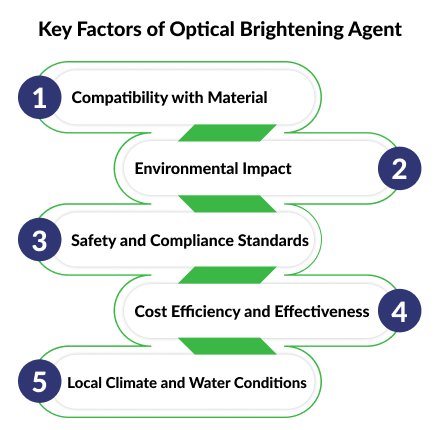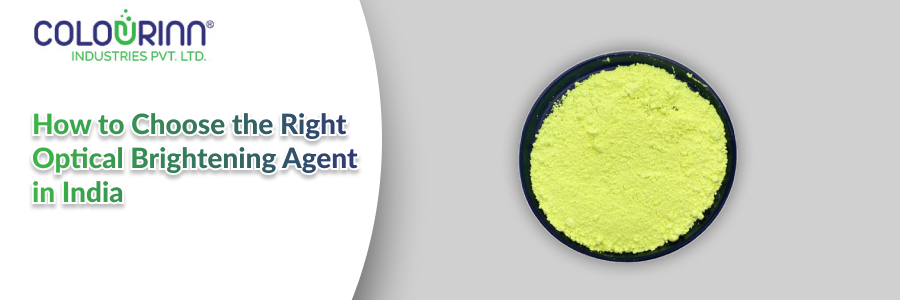Have you ever looked at some fabrics, papers, or detergents that are brighter or whiter than others? If yes, it’s all because of optical brightening agents or OBAs.
Optical Brightening Agents in India are quite high in demand as they make materials high-quality and visually appealing – especially in the textile, detergent, and paper industries.
With all the qualities that OBAs have to offer, manufacturers in India are more than keen to leverage all the applications of optical brightening agents for their business!
However, OBAs can only transform your business when you know how to choose the right optical brightening agent. So the question now becomes, how do you do that?
Let’s explore that and much more about optical brightening agents further in this blog!
First, let’s explore what OBAs are.
- What is an Optical Brightening Agent?
OBAs are basically special chemical compounds that help make things look brighter and whiter. They work by absorbing invisible UV light and turning it into visible blue light, creating a sort of optical “trick.” This trick makes fabrics, papers, and other materials appear cleaner and brighter than they actually are.
Most OBAs are made from specific chemical groups like stilbene, coumarin, or pyrazoline. These compounds are designed to be safe for everyday use, but it’s still important to pick OBAs that meet safety standards. After all, they’re used in things we handle every day, like clothes and detergents, so making sure they’re both effective and safe is key.
- Importance of Optical Brightening in Various Industries
Now that you know what optical brightening agent does, it’s time to explore their significant role across industries.
Here we have listed the industries that value the application of optical brightening agents in day-to-day life.
- Textile Industry:
The first and foremost industry that comes to our mind when it comes to the application of OBAs is the textile industry. OBAs help fabrics look cleaner and newer by creating a brighter and whiter appearance. And in a culture like India where maintaining a fresh, high-quality look is crucial for customer satisfaction, OBAs act like saviours.
- Paper and Pulp Industry:
The next industry that uses the OBAs the most is the paper and pulp industry. These OBAs give a very sharpening look and appeal to the notebooks and packaging materials
- Detergent Industry:
Next, all the products that claim to give a “fresh and new” look to your clothes are all possible because of the brightening agent in detergent. There’s no doubt that the innovation of OBAs has been a game-changer for the detergent industry.
- Other Uses:
Other than textile, paper, pulp, and detergent industries, OBAs are also used in the plastics industry, where they enhance the appearance of the final product, and in cosmetics, where they add subtle brightening effects.
Depending on the industry and application of OBAs you want to leverage, there are many factors that you need to consider while choosing OBAs.
So what are these factors? Let’s explore that in the upcoming section.
- Key Factors to Consider When Choosing an Optical Brightening Agent

If you have made up your mind about utilizing all the applications of optical brightening agents, it’s best practice to check these factors to make sure you are getting the right OBAs for your manufacturing.
- Compatibility with Material:
The first thing you need to check while choosing an OBA is its compatibility with your material. If you are dealing in textiles, it will require different kinds of OBAs formulation than what it requires in paper grades and detergent formulation.
Knowing which formulation would suit your material the best is key to success here!
- Environmental Impact:
India is changing now and businesses and people in general are becoming more eco-conscious. Moreover, there are some rules, regulations, and policies that require your business to follow sustainable practices. In such cases, choosing OBAs that are eco-friendly and biodegradable can help your business align with these goals.
Be a part of a greener future and contribute to a cleaner environment by choosing OBAs with eco-standards.
- Safety and Compliance Standards:
Moving next, as OBAs are used in the materials where they directly come in touch with human skin (textile and detergent), safety becomes a concern.
In such sensitive cases, it’s important to choose OBAs that meet global standards like ISO or REACH, as well as Indian safety standards, to ensure they’re safe for consumers.
If not chosen wisely, this can lead to many troubles for your business.
- Cost Efficiency and Effectiveness:
Once you have made sure that your OBAs are compatible with the material, have a good environmental impact, and meet safety standards, it’s time to make sure that they are also cost-effective with durable quality.
Making sure that you are the cost you are paying is bringing you enough value ensures that you are not overspending on OBAs.
- Local Climate and Water Conditions:
Lastly, you also need to consider local climate and water conditions while choosing OBAs. This is especially true in India as here our climate varies greatly across states and regions.
So while choosing an OBA, you need to make sure it can hold up in both humid and dry conditions as the hardness of water in certain regions can also impact OBA performance.
Considering these factors can help you find the OBA that fits your specific needs and delivers high-quality, consistent results.
- Choose Colourinn as Your Best Optical Brightening Agents in India
There’s no doubt that choosing the right optical brightening agent comes down to balancing quality, compatibility with materials, and environmental responsibility.
When you carefully consider all the factors that we’ve discussed above in the blog, we are sure, you’ll be able to select the best OBA for your needs – one that’s safe, effective, and perfectly suited to the Indian market.
You can always reach out to our expert team of OBAs at Colourinn to get the best options for your requirements while getting the best price and value at the same time.
Frequently Asked Questions
Q1. How do Optical Brightening Agents work?
A. OBAs work by absorbing UV light and re-emitting it as visible blue light, which offsets any yellowish tones in the material, making it appear whiter and brighter.
Q2. Are Optical Brightening Agents safe?
A. Yes, OBAs are generally considered safe for use in textiles, paper, and detergents. However, they should be used in appropriate quantities as regulated by industry standards.
Q3. Can OBAs be used with all fabrics?
A. OBAs are most effective on fabrics that are naturally prone to yellowing, like cotton and other natural fibres. Some synthetic fabrics may not respond as effectively to OBAs.

